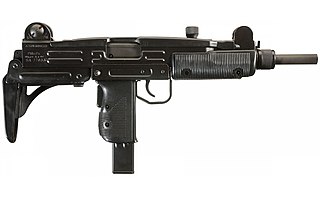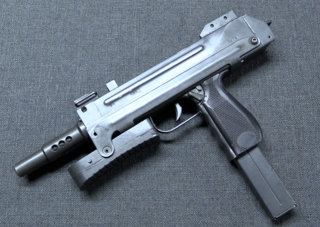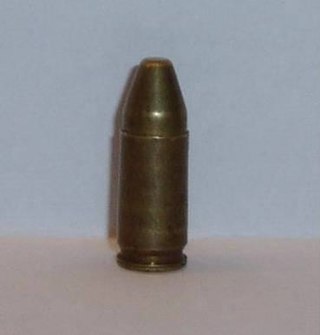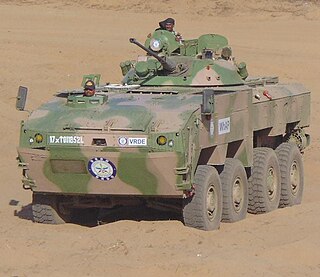
A carbine is a long gun that has a barrel shortened from its original length. Most modern carbines are rifles that are compact versions of a longer rifle or are rifles chambered for less powerful cartridges.

A submachine gun (SMG) is a magazine-fed automatic carbine designed to fire handgun cartridges. The term "submachine gun" was coined by John T. Thompson, the inventor of the Thompson submachine gun, to describe its design concept as an automatic firearm with notably less firepower than a machine gun. As a machine gun must fire rifle cartridges to be classified as such, submachine guns are not considered machine guns. The submachine gun was developed during World War I (1914–1918) as a close quarter offensive weapon, mainly for trench raiding. At its peak during World War II (1939–1945), millions of submachine guns were made for assault troops and auxiliaries whose doctrines emphasized close-quarter suppressive fire. New submachine gun designs appeared frequently during the Cold War, especially among special forces, covert operation commandos and mechanized infantrymen. Submachine gun usage for frontline combat decreased in the 1980s and 1990s, and by the early 21st century, submachine guns have largely been replaced by assault rifles, which have a longer effective range, have increased stopping power, and can better penetrate the helmets and body armor used by modern soldiers. However, they are still used by security forces, police tactical units, paramilitary and bodyguards for close-quarters combat because they are "a pistol-caliber weapon that's easy to control, and less likely to overpenetrate the target".

The Uzi is a family of Israeli open-bolt, blowback-operated submachine guns and machine pistols first designed by Major Uziel "Uzi" Gal in the late 1940s, shortly after the establishment of the State of Israel. It is one of the first weapons to incorporate a telescoping bolt design, which allows the magazine to be housed in the pistol grip for a shorter weapon.

The Military Armament Corporation Model 10, officially abbreviated as "M10" or "M-10", and more commonly known as the MAC-10, is a compact, blowback operated machine pistol/submachine gun that was developed by Gordon Ingram in 1964. It is chambered in either .45 ACP or 9mm. A two-stage suppressor by Sionics was designed for the MAC-10, which not only abates the noise created but makes it easier to control on full automatic.

The Arjun is a third generation main battle tank developed by the Combat Vehicles Research and Development Establishment (CVRDE) of the Defence Research and Development Organisation (DRDO), for the Indian Army. The tank is named after Arjuna, the archer prince who is the main protagonist of the Indian epic poem Mahabharata. Design work began in 1986 and was finished in 1996. The Arjun main battle tank entered service with the Indian Army in 2004. The 43rd Armoured Regiment, formed in 2009, was the first regiment to receive the Arjun.

The Sterling submachine gun is a British submachine gun (SMG). It was tested by the British Army in 1944–1945, but did not start to replace the Sten until 1953. A successful and reliable design, it remained standard issue in the British Army until 1994, when it began to be replaced by the L85A1, a bullpup assault rifle.

The 9×23mm Largo centerfire pistol cartridge was developed in 1901 for the Bergmann Mars pistol.
The INSAS, or Indian Small Arms System, is a family of infantry arms consisting of an assault rifle and a light machine gun (LMG). These weapons were developed in India by the Armament Research and Development Establishment and manufactured by the Ordnance Factories Board at its various factories. It was the standard infantry weapon of the Indian Armed Forces for almost three decades.

The BXP is a 9×19mm submachine gun developed by Andries Piek, with the fully automatic version finalised in 1978, and the semi-automatic version for civilians coming later in 1984. Due to an international arms embargo against South Africa, South Africans designed and manufactured some weapons as a small firearms industry developed locally. The BXP was one of these locally designed and developed firearms, and is considered the final stage of development of the line of hand machine carbines that started with the LDP in Rhodesia and the Kommando in South Africa. Produced originally by the South African company Milkor (Pty) Ltd, its name 'BXP' stands for 'Blowback eXperimental Parabellum', hinting both at its operating mechanism as well as its caliber. The original automatic version of the BXP was intended for use by South African law enforcement, including the South African Police, the Correctional Services, and the specialised airport security unit based at the then Jan Smuts International Airport, Johannesburg.

The Colt 9mm SMG, also known as the Colt Model 635 or Colt M635, is a 9×19mm Parabellum submachine gun manufactured by Colt, based on the M16 rifle.
In India, the Armament Research & Development Establishment (ARDE) is a laboratory of the Defence Research and Development Organisation (DRDO). Located in Pune, it is the main DRDO lab involved in the development of conventional armaments.

The 9×25mm Mauser is a cartridge developed for the Mauser C96 service pistol around 1904 by DWM. Mauser pistols in this relatively powerful caliber were primarily intended for export to Africa, Asia, and South America. The 9mm Mauser Export cartridge was produced specifically for Mauser pistols and carbines made from 1904 to 1914 and then later from approximately 1930 to 1945 for submachine guns chambered for this caliber.
The 5.56×30mm MINSAS is a firearm cartridge manufactured by India's Ordnance Factory Board (OFB) for close-quarters combat use. It has an effective range of 300 metres (980 ft) and good penetration against body armor. OFB claims it exhibits penetration superior to 9mm.

The Joint Venture Protective Carbine (JVPC), also known as Modern Sub Machine Carbine (MSMC) until 2014, is a gas-operated, magazine-fed, select fire carbine designed to chamber the 5.56×30mm MINSAS cartridge. It was designed by the Armament Research and Development Establishment of the Defence Research and Development Organisation, and manufactured by Advanced Weapons and Equipment India Limited and by Kalyani Strategic Systems Limited. It was intended as a replacement for the 9mm Sterling submachine gun in service with the Indian Armed Forces.

The 9mm Glisenti is an Italian pistol and submachine gun cartridge.

The Advanced Towed Artillery Gun System (ATAGS) is a towed 155 mm/52 calibre howitzer that is being developed for the Indian Army by Armament Research and Development Establishment (ARDE), Tata Advanced Systems (TASL) and Kalyani Strategic Systems (KSSL).

Ordnance Factory Tiruchirappalli (OFT), also called Ordnance Factory Trichy, is a small arms factory operated by Advanced Weapons and Equipment India Limited based in Tiruchirappalli, Tamil Nadu, which was previously part of Ordnance Factory Board of the Ministry of Defence, Government of India. The company is headed only by an IOFS officer called General Manager (ex officio Additional Secretary to Government of India) who is the chief executive officer, responsible for the overall management of the company.

The TATA Kestrel, also known as the IPMV , a variant of DRDO developed WhAP, is a family of armoured personnel carriers developed by Tata Advanced Systems and the Defence Research and Development Organisation (DRDO). It was developed to replace Soviet-era BMP-1 and BMP-2 and APCs in service with the Indian Army.

The SIG MPX is a gas-operated submachine gun designed and manufactured by SIG Sauer, and is primarily chambered in 9×19mm Parabellum. It is a gas-operated firearm featuring a closed, rotating bolt. These design features, rare in submachine guns, were chosen to enhance the safety of the user and to have a more reliable firearm. It was designed in 2013 and was released to the general public in 2015. It features the SIG Sauer short stroke push-rod gas system to reduce the recoil and improve the reliability of the weapon.

















